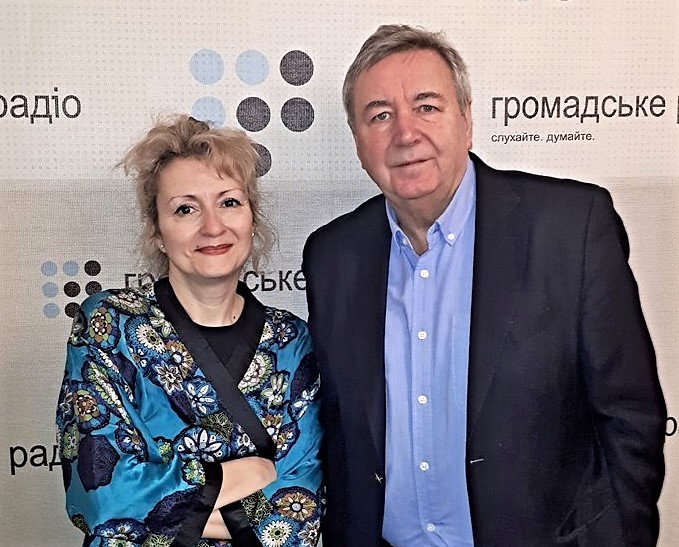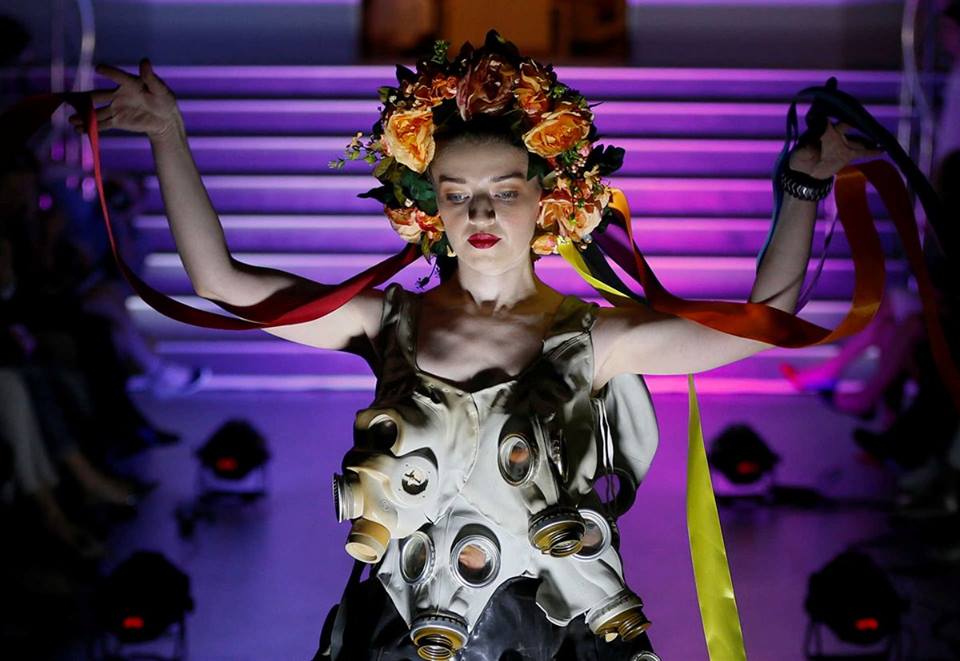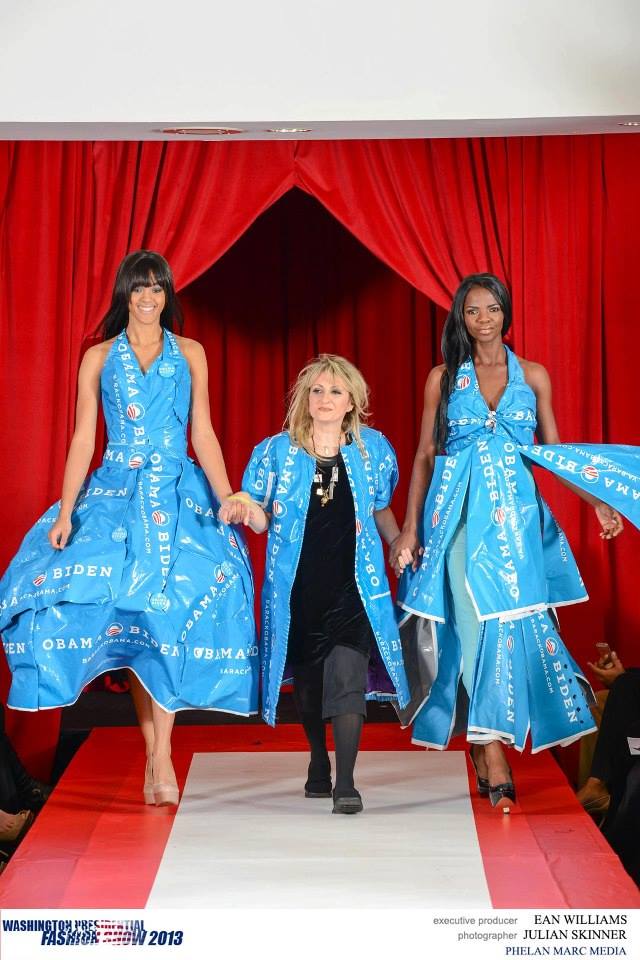
Ukraine is original in its own way of being fashionable, – Isagus Toche
Bohdan Nahaylo interviews French eco-designer Isagus Toche who now lives and works in Kyiv: vyshyvanka fashion, Ukrainian designers, and much more

Hello and welcome to this week’s episode of Ukraine Calling. I’m Oksana Smerechuk for Hromadske Radio in Kyiv. This week it’s been Fashion Week in Kyiv. We’ve had Ukraine’s up and coming design talents parading their models on the runway. Would you say that we’re observing a unique fashion style developing here in Kyiv? Or would you say that the fashion scene here is a sign of overconsumption, just like everywhere else? Bohdan Nahaylo talks to Isagus Toche, a French designer and artist, whose work itself is a comment on the fashion scene.
Nahaylo: Welcome to our latest edition of Ukraine Calling for Hromadske Radio in Kyiv. I am delighted that the guest is from the fashion world- Isagus Toche – she will correct me in a second – a French woman living here in Kyiv for several years who is very well known on a fashion scene and who specializes in eco-fashion. She will tell us more about this in the course of our discussion. She is obviously well placed to assess the state of Ukrainian fashion, and this week we have Fashion Week again in Kyiv. She is also active on the social scene and can share her impressions of life in Kyiv these days. Welcome to the program! May I call you Isa?
Toche: Yes, Isa is okay.
Nahaylo: Isa, tell us how long have you been in Kyiv? How did you end up in Kyiv?
Toche: I’ve been here two and half years. I came here because my husband was posted here.
Nahaylo: He is a diplomat.
Toche: Yes, he is.
Nahaylo: First impressions, as opposed to best impressions?
Toche: I love it. I love Kyiv. I love Ukraine. I had never expected that I would love it so much.
Nahaylo: And where were you stationed or based before?
Toche: Before I was in Albania, Washington, and Latin America.

Nahaylo: I saw on the net that you had fashion exhibitions in Washington. We will talk about this in a second. So when you arrived you were already known as a designer. Was it difficult to pick up and start here in Kyiv?
Toche: No. Because when I was posted in Washington half of my models were Ukrainian, or of Ukrainian background. When they learned that I was going to settle in Kyiv they connected me with their friends, photographers, etc. So it was very easy for me on arrival here.
Nahaylo: Many of us think that after Euromaidan and the Revolution of Dignity the ethno-fashion – Ukrainian embroidery and national costumes motives – has become very popular. But you are suggesting that there were already many models. Was there any particular reputation that the fashion scene in Ukraine had in the external world at that time?
Toche: Yes, I think so. The “vyshyvanka” [embroidered shirt or blouse in Ukrainian national costume] was already popular because my friends in the US were wearing them. Everybody was fascinated by vyshyvanka fashion.
Nahaylo: Is it exclusively Ukrainian? Because I remember Romanians have something similar, didn’t they?
Toche: Yes, Romania and many other countries. I find some similarities between vyshyvanka [Ukrainian embroidery] and some Mexican designs. Its folk traditions that connect in a way with many other countries.
Nahaylo: What changes have you seen? What growth and developments in the sphere? As an amateur observer I have noticed that Ukraine seems to be more noticeably represented in the fashion world and in classical journals like Vogue.
Toche: It is more and more every year, I think. In Paris, for example, there were a few nominees from Lois Vuitton’s prestigious prize in 2015-2016.
Nahaylo: Is it just the product, with the colors and the motifs, or are there now also talented and recognized local designers as well?
Toche: I think some Ukrainian designers are very original and they have a really good place in the worldwide market. Of course, it’s a big, big market and it is difficult to arrive at this stage. But I’m pretty sure you have a lot of active women and representatives of Ukrainian designers in New York Fashion Week, in Paris, and in Los Angeles that try to promote Ukrainian designers, and I think they are very active.
Nahaylo: So Ukraine is recognized on the fashion scene in the outside world?
Toche: Yes, and it is more and more. Stars in Hollywood and singers are interested [in what it offers].
Nahaylo: So it is popular, trendy?
Toche: Yes because it is different! I became a designer because I didn’t want to wear the same clothes as everyone else and I think that Ukraine has something different that can be promoted outside.
Nahaylo: I’m speaking to Isagus Toche from France who is a fashion designer— among other things—and you specialize, well certainly since you’ve been in Kyiv, in what we call ‘eco-fashion’. Can you tell us a little bit about what that involves?
Toche: I began this IsagusExtroversions collection made of trash or everything that nobody wanted anymore, recycled materials, because it was my reaction against the over-consumption society we are living in. Particularly, I was living in Washington D.C., in the United States, and I was overwhelmed by all the trash everywhere all the time. Because I’m fascinated by fashion, I have this ambiguous relationship with it. I’m fascinated of course, but at the same time I hate the ‘fast fashion’ for example that is polluting so much of the planet. The fashion industry tries to make us buy more and more, but where is all this stuff that is produced going afterwards? Of course it is a terrible thing, so I wanted to talk about it.

Nahaylo: And what kind of materials are you using?
Toche: Anything I find in the trash, dolls heads, plastic bags, anything!
Nahaylo: Yes, I was at one of your exhibitions and there were dresses made with gas masks, can openers put together, among the things I remember. Quite amazing because when one listens to you talking its hard to imagine how they would look like on a model and yet you put them together so gracefully and effectively that it really works and people go ‘wow!’ when they see this.
Toche: Yes, because I try to make beauty with trash. It was a challenge. I was very curious when I began if it would be successful and if it would be a good medium to send a message through fashion, and it worked.
Nahaylo: And of course, being in Ukraine, you’ve reflected the Chernobyl theme. Are there any other themes that you’ve picked up here that are more specific to Ukraine in your view?
Toche: Well, the war, of course. I have a gun dress for example that I made with the purpose to protest against the gun laws in the United States but it works in a country where there is a war going on. And many other environmental issues of course.
Nahaylo: Could you just describe what this gun dress looks like?
Toche: It is impressive. It is a dress made all out of parts of guns.
Nahaylo: Amazing. If we can find a photo maybe we can post it on our page.
Toche: We got arrested in Miami two years ago with this gun dress.
Nahaylo: Wow, interesting! So who here are interested? Is it just the very wealthy, or younger people, or middle class? Who are interested in the kind of cutting edge fashion that you represent?
Toche: Well, I think the fashion world look at me as a phenomenon, not like at a serious person, and I think I am not a serious person. I just try to protest and this is my voice. And they invite me because I think they like what I am doing.
Nahaylo: How do your Ukrainian friends respond to you? Are they supportive? Do they understand? Do they care?
Toche: Yes, I have a lot of support. I think, yes. But I consider myself more an artist, than designer or a fashion designer. I design my own clothes, but I really feel that I want something larger than just the fashion.
Nahaylo: Let us return to fashion because it is Fashion Week in Kyiv. How would you assess this event? Is it well organized? Does it have an international component, or is it still fairly provincial, introverted?
Toche: I like it. I go every year. I think the way they organize it is very professional. Some of designers are really good, according to my taste of course.
Nahaylo: Whom would you mention as somebody to watch, somebody that is really top class nowadays?
Toche: My friend who is posted in Bishkek and before was in Switzerland wrote me the other day an email saying: “Oh, I met Fedir Vozianov. You should know him.” And I said: “Okay, I know, he is my neighbor. I know that he is very good , etc.” So, Vozianov is a phenomenon, I think, because his works are a kind of show. He is doing very simple shapes. He is doing dresses with a square, circle or a cross like a Swiss cross – very perfect equilibrium shapes. I am fascinated by the way how in just in five minutes he can make a dress.
Nahaylo: Do you feel that in, what we call Ukrainian fashion these days, there is a traditional basis, the basis which reflects folk motives, ethnic motives?
Toche: Personally I like very much when Ukrainian designs are mixed with a traditional vyshyvanka or other kind of roots or ethnic motives. I like. This is my style, I love it. But, of course, you can also modernize it. I think there are a lot of brands now that are trying to make a mixture of it, and take the better part from each: the modern and traditional.
Nahaylo: And say, compare to neighboring countries in the East, compared to Russia or to Poland, or to Belarus, or Romania, does Ukraine hold its own?
Toche: Yes, I think so. I think Ukraine is original in its own way of being fashionable.
Nahaylo: Are Ukrainian designers finding their own way?
Toche: Yes, for example if I take Poland, I think they are now in the bigger European Union. So, they try to be like them, maybe. And what I like in Ukraine is they are not yet so. Maybe I would like them to stay the way they are.
Nahaylo: A question of authenticity and originality, yes?
Toche: Yes.
Nahaylo: Okay, give me your thoughts on Ukrainian models. Ukrainian women have a reputation for being attractive, if not beautiful. This is the English under-statement coming out from me. They have been known for quite some years now as models and film actresses, etc. Are there schools here producing these models? How do they originate? How do they get out into that outside world?
Touche: I suppose they are, but my models are all my friends, so I don’t need to find agencies. Now, I will have a show in Kharkiv with the French Spring event and the French embassy is sending me there for the opening. Of course, they will ask an agency to find models because I don’t know anyone there. But, I don’t know which model agencies are working in Kyiv, for example.
Nahaylo: And about yourself now. Apart from working in Ukraine, now Kharkiv, have you had any exhibitions recently abroad?
Touche: Abroad? I’m always up for protesting in the US for example.
Nahaylo: You’re not a great fan of President Trump?
Touche: No, not really. I did an anti-Trump show, and my Facebook was closed after, so yeah. No, not really.

Nahaylo: And what are those dresses I saw with Obama’s name on them when you did some show in Washington?
Touche: Yes, I was living in Washington and I was seeing all those posters with this very nice blue – I call it ‘Obama blue’ – and I wanted to recycle them and make a collection. The collection was called ‘Obamanyak,’ and it was presented for the second inauguration of Obama, so I was very happy.
Nahaylo: Congratulations.
Touche: And it was my birthday, so for me, it was like double birthday gift.
Nahaylo: So perhaps, at the inaugurations of a new president in Ukraine, there’s also a role for you? Who knows what the future holds.
Touche: I would never do it, for example, for the French election. Never. But, maybe because it’s not my country, it was easier for me to take part.
Nahaylo: Okay, well just some parting thoughts, reflections on Ukraine. You say you like it, what is it you like about Kyiv? What in particular do you like about it?
Touche: I like people. First of all, I like Ukrainians very much. I like the emotional part in them – the way they express themselves. Yes, this is the first thing I like, and I think Kyiv is beautiful. And what else…?
Nahaylo: And the social life is not bad when you’re in the fashion community?
Touche: When I talk about people, I talk of course of my social life, yes.
Nahaylo: Well, I thank you very much. Let me just ask you for a message – I always ask my guests, if they have a message, particularly for the younger people, about the way to go forward, whether it’s about perseverance or working hard. What would you say from your experience?
Touche: Keep focused. Never lose sight of the goal that you really want to reach.
Nahaylo: Stay focused! Keep on track! Well, I thank you very much. I’ve been talking to Isagus Touche, who is a French fashion designer, artist, as she says, who is enamoured by Kyiv – has been here for several years – and a very well-known person on the social-cultural scene here in Kyiv. I thank you very much, Isa.
Touche: Thank you very much for inviting me.
MUSIC
In February we’re all looking for more sun. There’s a group in Kyiv called Second Sun, Друге сонце, and they have a song that’s not really about the sun, but it’s wonderfully evocative in the music and lyrics. The song is called Світ з химерами, A World with Chimeras. Enjoy!
LOOKING FORWARD
Next week we’ll be focusing on protests. Marta Dyczok interviews a leading expert on the subject, Olga Onuch of Manchester University in a new edition of Ukraine Calling. We would be happy to receive any feedback from you. Write to us at: [email protected]. This is Oksana Smerechuk in Kyiv. Thanks so much for listening.
Interview transcribed by, Caroline Gawlik, Larysa Iarovenko, Nykole King and Ilona Sviezhentseva. Music by Marta Dyczok. E-mail distribution by Ilona Sviezhentseva. Sound engineer Andriy Izdryk. Web support Kyrylo Loukerenko.


